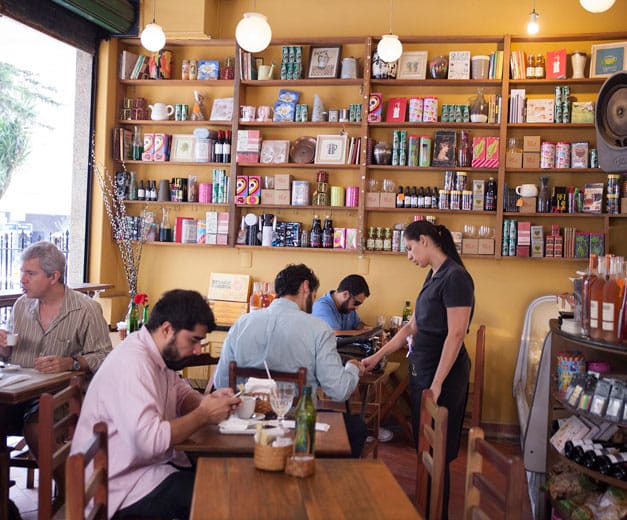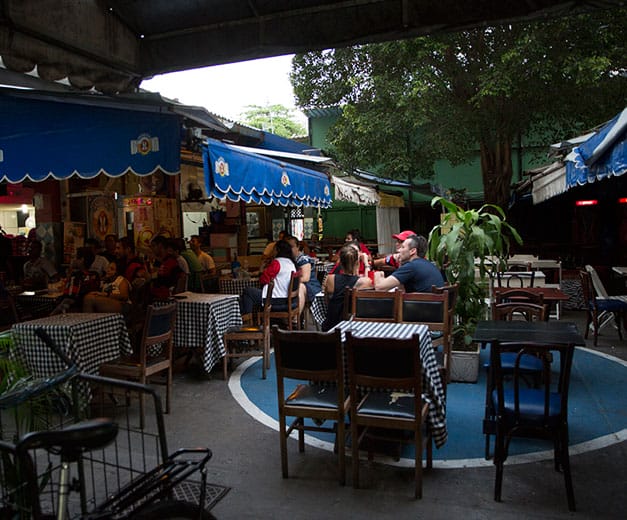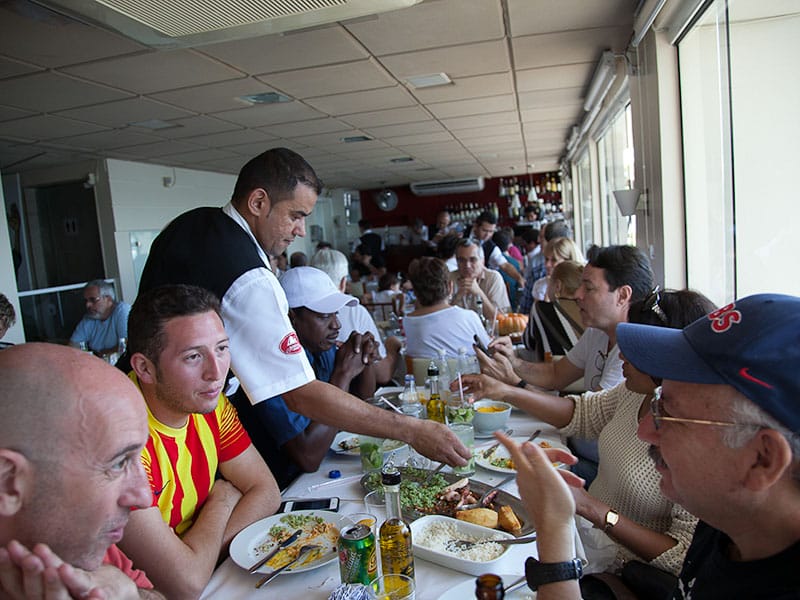If there is a word to describe the Laranjeiras (“Orange Trees”) neighborhood, it is “pleasant.” Agradável. Agreeable. As you walk up its main drag, Laranjeiras Street, you pass by the creamy yellow and white façade of the elegant 19th-century National Institute for the Education of the Deaf on your right. Soon, on your left, you could come across the youth orchestra Camerata Laranjeiras playing free concerts at the General Glicério fair. It’s measurably Rio’s most progressive neighborhood – in the 2012 mayoral election, it was the neighborhood that most favored human rights activists and opposition candidate Marcelo Freixo (48 percent of the neighborhood voted for him in the election against Mayor Eduardo Paes, whereas the city as a whole voted only 28 percent for Freixo). Follow the rising street to its top and you’ll find yourself at the tourist train, ready to go visit the Christ statue.
When Ricardo Linck was ready to leave his career as a TV journalist, his mother-in-law spotted a butcher shop on a corner near them in a residential corner of Rio so tranquil that you just nearly forget the traffic jams, smog and those unsightly pipes carrying raw sewage to the ocean. Here, instead you see parents walking their kids back home during the afternoon and dog walkers ambling around throughout the day.
Linck’s mother-in-law saw a “for sale” ad for the butcher shop in the newspaper, and he planned to buy it and make a deli similar to one his wife already owned. But friends told him, “This is the kind of place where people want to sit down, relax and have a chat – perfect for a café.”
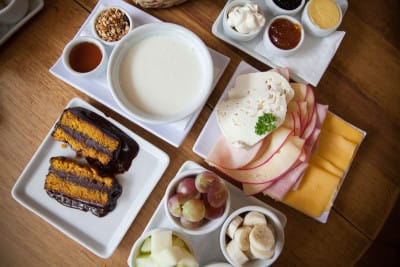 Although Brazil is one of the world’s most prominent coffee producers, Rio’s café culture is pretty much nonexistent. Coffee here is usually drunk in black shots heavy on the sugar and light on the wait time. Clients grab their tiny cuppa in thumbnail-sized plastic cups or small glasses and drink it while standing at lanchonettes, or snack bars. Coffee is to be taken in small doses; beer is the drink of leisure and lounging.
Although Brazil is one of the world’s most prominent coffee producers, Rio’s café culture is pretty much nonexistent. Coffee here is usually drunk in black shots heavy on the sugar and light on the wait time. Clients grab their tiny cuppa in thumbnail-sized plastic cups or small glasses and drink it while standing at lanchonettes, or snack bars. Coffee is to be taken in small doses; beer is the drink of leisure and lounging.
That’s why Linck’s charming Maya Café, named for his daughter, stands out. We recommend it for breakfast, though it crossed our mind that, with its thoughtful beer and wine selection, it could make a good night out as well. Linck does the basics and does them well: The Maya Café breakfast, at an economical price of 70 reais (or about US$18.50) and which could stuff three people, comes with perfectly toasted buttery croissants, cream cheese and apricot jam, three different types of sliced cheese, four fruits and plain honey and yogurt to mix them with. We had ours with a nicely tart orange-blackberry juice.
The sandwiches are popular at lunchtime and during happy hour, which, according to Linck, is frequented by mothers who’ve just picked up their kids from school. One of his most popular is pork sausage – made just for the café – with honey mustard, caramelized onions and Gruyère. Regulars also like the pastrami with olive-herb sauce. We 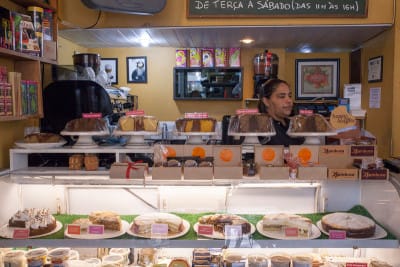 most appreciated his beer selection. Right now he has several Japanese imported beers (Hitachio Nest White Ale is a tasty one with notes of coriander, nutmeg and orange peel), but Linck says he’s cycling them out in favor of Brazilian ones, both to minimize his carbon footprint and because Brazilian craft beer just keeps getting better and better. He suggests the Röter Weiss, with banana and clove flavors and produced in the interior of Rio de Janeiro.
most appreciated his beer selection. Right now he has several Japanese imported beers (Hitachio Nest White Ale is a tasty one with notes of coriander, nutmeg and orange peel), but Linck says he’s cycling them out in favor of Brazilian ones, both to minimize his carbon footprint and because Brazilian craft beer just keeps getting better and better. He suggests the Röter Weiss, with banana and clove flavors and produced in the interior of Rio de Janeiro.
Linck’s success as Brazil enters its worst economic crisis in two decades seems to say something about his enterprise. “Everyone is talking about the crisis. We’re not having that here,” he said. In fact, he added, “We’re hiring.”
(photos by Nadia Sussman)
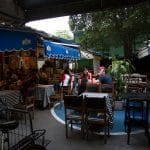 September 19, 2014 Mercado São José das Artes
September 19, 2014 Mercado São José das Artes
Brazil is relatively young – it declared independence from Portugal in 1822, and the […] Posted in Rio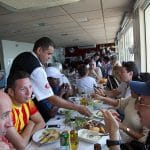 October 9, 2013 Bar Urca
October 9, 2013 Bar Urca
In a city with no shortage of postcard views, Bar Urca’s may get the title for most […] Posted in Rio May 3, 2021 Wheel Hospitality
May 3, 2021 Wheel Hospitality
Bars, cafés, taverns and restaurants have historically functioned as meeting spots for […] Posted in Barcelona
Published on September 21, 2015
Related stories
September 19, 2014
RioBrazil is relatively young – it declared independence from Portugal in 1822, and the first republic was established in 1889 – but in comparison, Rio de Janeiro is an old city: In 2015, it will celebrate its 450th birthday. The city has seen a great deal of history unfold over the centuries, and many sites…
October 9, 2013
RioIn a city with no shortage of postcard views, Bar Urca’s may get the title for most picturesque. The eponymous residential neighborhood where the bar is located faces Guanabara Bay, where a colorwheel of boats and yachts bobble on the slow waves leading up to the seawall. Across the bay, the iconic Christ statue watches…
May 3, 2021
BarcelonaBars, cafés, taverns and restaurants have historically functioned as meeting spots for all kinds of urban communities, from intellectuals to politicians and artists –revolutions have even been planned around the table. Nowadays in Barcelona, another community, one that has flourished in numerous cities around the world, has started gathering in these types of venues: cyclists.…







































